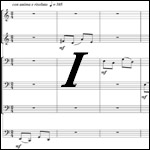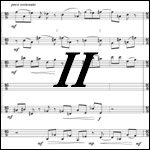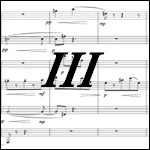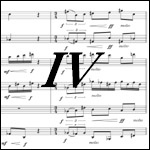For Brass Sextet.
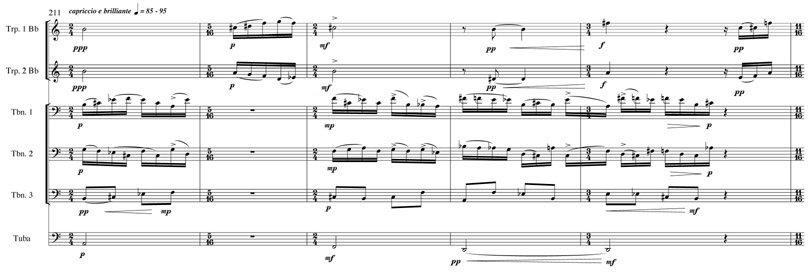
from the opening of Ricercare IV.
![]()
The brass sextet of trumpets, trombones and tuba is the standard complement of brass instruments found in most symphony orchestras, the french horns occupying an independent position between woodwind and brass. Such a sextet has its roots in the brass ensembles found in music of the sixteenth century composer Giovanni Gabrieli, in particular his elaborate ricercares written for perfomance in Venetian churches. These four Ricercares look back to those Venetian pieces and also to the origin of the word ‘ricercare’ meaning ‘research or experiment’. But in common with most experimental research this elaborate composition looks forward into the new musical territory that can be explored with computers. Most computer music research focuses on exclusively sonic adventures, but there is a consistent strand of interest in how computers can be a composer’s assistant, generating the complex interaction of the traditional musical parameters of pitch, rhythm, harmony, dynamics, articulation and orchestration. This is the area Nigel Morgan has explored in his work as co-developer of the Symbolic Composer software (one of the longest established commercially available systems for algorithmic composition) and more recently as a research associate and composer in residence with the Interdisciplinary Centre for Computer Music Research (ICCMR) at the University of Plymouth.
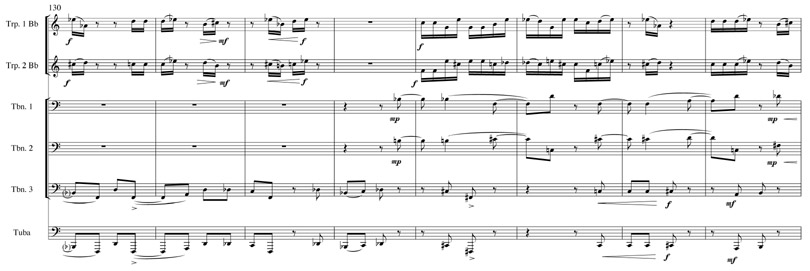
part of the final section of Ricercare I.
![]()
Ricercares is a particularly significant piece in the development of Nigel Morgan’s work with algorithmic composition, a preoccupation that extends over nearly twenty years resulting in some 60 compositions. Composed in 1994 Ricercares established a number of approaches to writing ensemble music with generative algorithms and intelligent event processors that are now form a library of software tools at the heart of the music that belongs to Instrumentarium Novum. Indeed, Ricercares, written some 8 years before this expanding collection of instrumental scores, can be regarded as part of that collection along with the radical Metanoia of the mid 1980s. In general the trace of algorithmic generation and event processing common to many of Nigel Morgan’s compositions is usually available as downloadable collection of annotated and illustrated score-files. In this presentation of Ricercares, whilst the scorefiles are available to download, a gentle introduction is given alongside music examples to highlight something of this unique approach to music composition.
Each of the four Ricercares is based on identical source material. This is a stream of symbols converted from the vector plotting of the generation of a 50 milliseconds burst of white noise.
These symbols are then mapped to make a lattice of tonality slots or converted directly to musical pitches.

In all algorithmic composition a key issue for a composer is how such numerical material can be mapped effectively to musical parameters such as pitch, note length and dynamics. The Symbolic Composer software provides a many different options and possibilities for such mapping, so one is never stuck with a single solution or direction. What happens in the course of Ricercares is that the source material takes an elaborate journey across newly invented tonalities, to chromatic and unusual pentatonic scales, and finally to whole-tone sequences organised around the cycle of fifths. Pitch melodies are scaled, filtered, randomized, inverted, and transposed. Note lengths are associated directly with particular pitch collections and registers. Dynamics and articulation schemes are created directly from examining segments of the white-noise pattern. The play of instrument activity, contrapuntal variety and silence is often organised by making an analysis of proximity and density of the source material.
To explore the individual ricercares, click on the images below:
Ricercares was written for the brass section of the English Northern Philharmonia who perform independently as Yorkshire Classic Brass under the direction of trombonist and conductor Chris Houlding.
Study Score [pdf]
Instrumental Parts [zip] (11mb)
Reference Recording – 1 [mp3] 2 [mp3] 3 [mp3] 4 [mp3]
Symbolic Composer code [zip]

